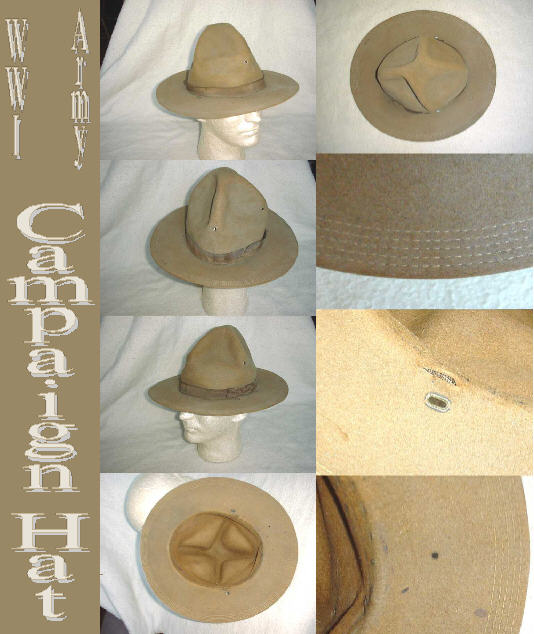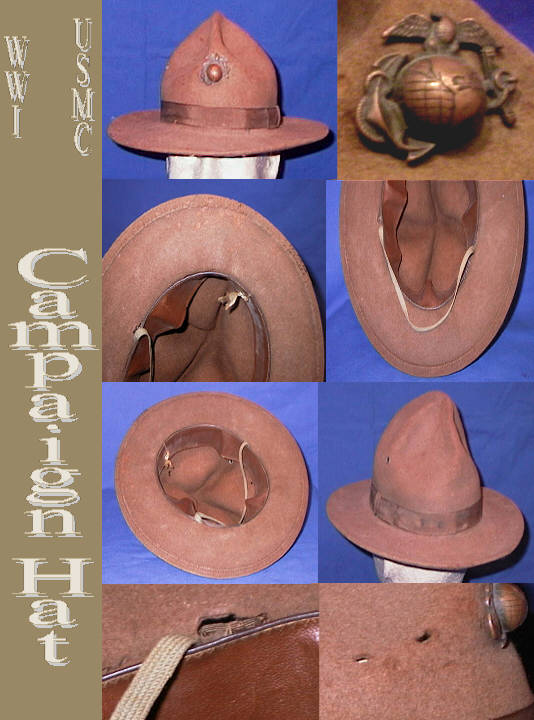Create Post
Results 1 to 2 of 2
Thread: Campaign Hat
-
01-15-04, 01:57 PM #1
 Campaign Hat
Campaign Hat
Campaign Hat
36th Division Trainees
Sporting their Campaign Hats
Introduction
As a novice collector of American World War One material I found little in the way of literature to identify period makes of the service hat. So I have taken upon myself to research and identify period makes and manufacturers of this headgear. This is a rough outline based mostly upon my own collection and is in no way a definitive work, as much more research needs to be done -- each hat was as individual as the man who wore it. Hopefully those with collections, info and ideas will come forward and add to this work. Only time will tell if there is interest enough for me to publish a reference volume. I hope you enjoy it and please contact me with comments criticism and information. Thanks.
Background
I have divided identification of service hats into time periods, obviously manufacturing contracts did not follow such a clear cut pattern.
1911-1916
1916-1920
1920-1942
1911-1916
This is the period when the US Army adopted the "Montana peak" style, officially on September 8, 1911. As to their origin one can only guess. Previously in the Spanish-American war and Philippine Insurrection many troops peaked their M1883, M1903 hats this way rather than the regulation fore and aft crease, in order to shed water better. This service hat has 4 ventilation holes on each of the peaks, all are perpendicular, to the 3 inch brim.
Hats of this era have the following characteristics: 2 to 8 rows of stitching around the edge of the brim, most common is 5 rows, no grommets for a leather chin strap on the brim, and a high peak of about 5 3/4 inches in height, (measurements are taken from the inside of the hat). Also underneath the sweatband are two small holes with circular brass grommets. This is to let the shoestring chinstrap pass through and underneath the sweatband down to the chin. The sweatband itself is not sewn to the body at this point in order to let the strap pass through. The shoestring tie runs underneath the grosgrain ribbon behind the ears and at the back of the hat. A makers trademark or name may be present on the sweatband, usually this applies to General officers' hats. Most of the ones that were enlisted personnel did not. The differences between officers and enlisted men are the following and apply throughout the next thirty years: HIGHER QUALITY OF FELT [1], usually a darker shade of olive drab for officers; enlisted mens' hats were of a lighter shade of olive [2], ( almost tan in colour and a lower density of felt around 3 or 4 X's); and as mentioned, a hat makers trademark is on the sweatband, and the store trademark where purchased is present only on officers; e.g. John B. Stetson Co., and Greenewalds, of South Carolina.
1916-1920
This is the time period when the US entered the war and as such, massive quantities of material were needed to feed, clothe, and equip and army. Enlisted hats of this period have similar qualities as the previous era save a few subtle differences. One is the appearance of metal grommets for a leather chinstrap, and the disappearance of shoestring ties. Also Quartermaster stamps with the following: contract number [3] and manufacturer in black ink. are present under the sweatband. But most importantly the "tell tale" marking of a World War One hat is the "United Hatters Union of North America" paper tag approximately 1 inch by 1 inch tag has the following details: two hands shaking superimposed over a globe with crossed US Flags at the side and underneath is the words:"registered trademark."
Another feature is the construction of the ribbon, it has the following characteristics: alternating thick and thin ribbing, usually one thick followed by two thin and another thick, earlier and latter models of hats have standard thin ribbing all along with no alteration of sizes. By the end of 1920-21 ornamental stitching no longer appears on enlisted hats. Again research shows many companies got contracts to produce hats and variations abound. It is up to the collector to determine if the hat is genuine. Another feature is the reed used to make the sweatband stiff and apply a base between the felt and the leather, after 1920 or so reeds weren't necessarily used and plastic and other materials replaced them.
When the doughboys made it overseas and into the front the campaign hat had to be stored somewhere in order to wear the new steel helmet issued. The hat was too big to be stored in the pack and space was at a premium in the rear. Eventually the overseas cap was adopted and those units not actively at the front were to use the service hat in the rear. Some were taken to be cut up and used a felt slippers for the wounded.
P1912 USMC Service hat
This hat was also made of wool or fur felt and was identical to the Model 1911, except for the following: a three inch brim folded over with two rows of stitching, and three vents in the crown but no rear vent. Officers where the only ones allowed to wear a hat cord. Theirs' is scarlet and gold. Again the EGA (eagle globe anchor) device was attached to the front vent for both officers and enlisted.
1920-1942
Between the wars, the service hat changed little, except it now became thicker in density and the high peak of earlier years was reduced to a dome shape peak about 5 1/4.inches. Quartermaster markings were still in place underneath the band in ink, and Officers still purchased their own. Another feature is the changing of the United Hatters tag, now smaller but still the same design with the addition of the following: " United hatters and milliners union of North America Registered trademark." Smaller ventilation ports and an increased size of the chin strap grommet, were some of the manufacturers changes. It was at this time the US army decided to restrict the use and replace the campaign hat for good. The hat saw service in the Pacific theatre and Alaska, only the mainland Cavalry were still issued it at this time (1942-1945).
Army

USMC

continued.......
-
01-15-04, 01:58 PM #2
Conclusions
This hat proved well both in the field and in the garrison, it was well received by all branches of the Army. It provided unsurpassed protection against the elements and when worn for this purpose redeemed it self admirably. However, with the advent of modern war it impracticable against combat conditions. Although, it is associated with the AEF, many Doughboys wore the flat, easily folded overseas cap which was much easier to store than the Campaign Hat. The campaign hat is still worn by many US State police Forces and Armed forces drill instructors. Today, collectors can pick up an enlisted service hat for anywhere between $34 to $140 depending upon condition and who's selling it. Officers are a little higher, a Stetson can go for $149-200. USMC hats are extremely rare; in 1998 one went for $300, the price now is $620 on average.
Notes and Details:
[1] Highest quality fur felt was used, however some cheaper models were exclusively wool. Which has a rougher texture and is not as durable.
[2] This was not always true. Some were dark brown to fawn tan, majority in my own collection are fawn coloured, and officers darker in shade.
[3] Early war contract number: Ferry hat Co. New York May 5-1917, late war number: 219-N Ferry Hat Co. New York.
I have provided a list of manufacturers of service hats for the US army during 1917 taken from the Military Affairs committee of United States senate 1918.
Hat manufactures during 1917-18
A Stetson Advertisement During the War
Initial shipment 18 000, and average of 2,173 hats per month were shipped overseas from April 12 to December 19, 1917. The following are manufacturers:
Rothschild Bros.
Arthur B. Waring
Ferry Hat Co.
Wm. H. Hoistmann Co.
Wm . J. Dixon & Co.
Delohary Hat Co.
Triest & Co.
Hudson Hat Co.
Waring Hat Co.
S. Eisner
A. B. Waring Hat Co.
H. Tenny & Co.
Jos. Fish Hat Co.
W. Alexander & Co.
Peekskill Hat Co.
Parmelee Hat Co.
Robt. Marshall Co.
Friest & Co.
Famous & Band Co.
Arostein & Bros.
Thom Hat Co.
Geo. Hendel & Sons
Wm. Campbell
E. Lowe & Co.
And of course the John B. Stetson Co. of Philadelphia Pa.!
Special Thanks to the following people and organizations:
Major Steve Mcgeorge ( Ret), Howard and Duncan Aran, Louise Arnold-Friend, US Army Military History Institute.
References:
Machado, William C. Uniforms and Equipment of the Last Campaign, 1916 The pursuit of Pancho Villa.
US Army Uniform Regulations 1912.
USMC Uniform Regulations, 1998.
Gawne , Jon Over There! Uniforms and Equipment of the American Soldier in World War One, 1997.
Otoupalik, Hayes World War one Collectors handbook, 1977, 1988.
Investigation of the War Department, Hearings before the Committee on Military Affairs United States Senate, Part 2 , December 18-29, 1917.
Chamberlain, Weston Col, and Weed, Frank Lieut. Col. The Medical Department of the United States Army in the World War Vol. VI Sanitation., 1926.
http://www.worldwar1.com/dbc/camph.htm
Sempers,
Roger

Thread Information
Users Browsing this Thread
There are currently 1 users browsing this thread. (0 members and 1 guests)



 Quote
Quote
Ghost Of Iwo Jima
04-04-24, 11:35 PM in Open Squad Bay